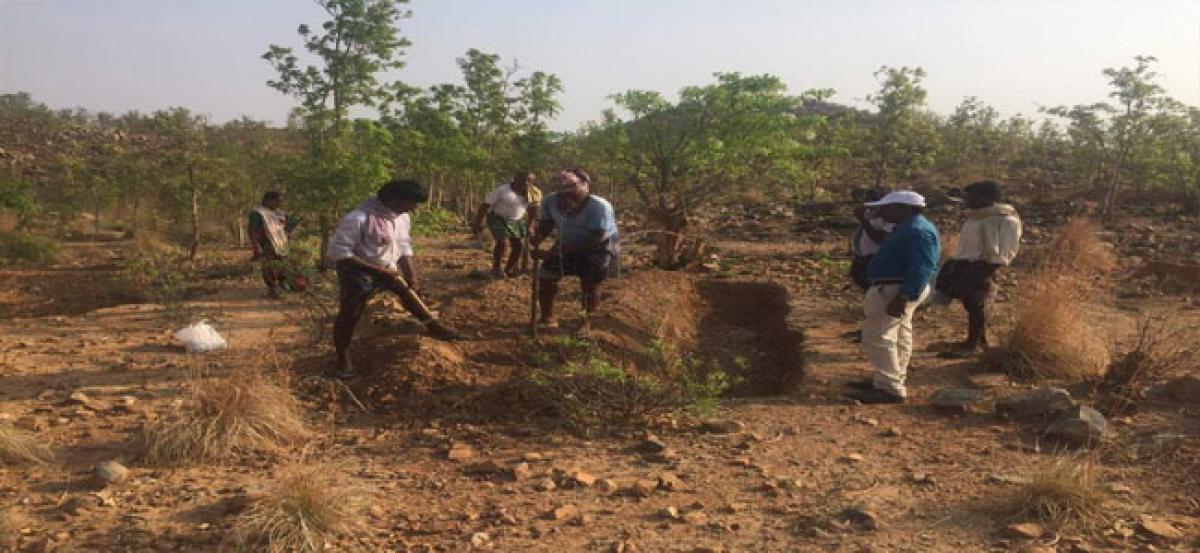Live
- GMR Airports Unveils AI-Powered Digital Twin Platform to Transform Airport Operations
- India poised to become leading maritime player: PM Modi
- Top Causes of Kidney Stones and How to Recognize Silent Symptoms
- India’s renewable energy capacity logs 14.2 pc growth at 213.7 GW
- Winter Session of Odisha Assembly adjourned sine die
- Biden calls Trump's tariff approach 'major mistake'
- After Drama Over Eknath Shinde’s Chief Minister Race, Maharashtra Cabinet Formation Faces New Tensions
- Egyptian FM, Blinken discuss recent developments in Syria
- Iran's supreme leader says Syria's developments result of US-Israeli 'plot'
- Elon Musk to Purchase $100 Million Luxury Mansion Next to Donald Trump's Mar-a-Lago, Report Reveals
Just In

More than 28 mandals have been covered under the Greening of Hillocks scheme in the district and around 101 hillocks which were once bald have been brought under the greening project in the watershed areas in the district, thanks to the District Water Management Agency (DWMA) which is on a mission to plant 11 lakh saplings spread over in 845 hectares of dry land.
Singanamala (Anantapur): More than 28 mandals have been covered under the Greening of Hillocks scheme in the district and around 101 hillocks which were once bald have been brought under the greening project in the watershed areas in the district, thanks to the District Water Management Agency (DWMA) which is on a mission to plant 11 lakh saplings spread over in 845 hectares of dry land.
Highlights:
- DWMA sets target to complete plantation in 100 hillocks in 28 mandals by Aug 31
- 66,000 trees planted in 150 acres spread over 10 hillocks
As of now, 10 hillocks have excellent green cover and plantations are spread in 150 acres with 66,000 trees planted. The greening of 100 hillocks now in various stages of plantations is expected to be completed by the end of the month.
Integrated development is ushered on the concept of ridge to valley treatment in the watershed areas in the 28 mandals. DWMA had undertaken integrated development of the targeted area promoting dry land horticulture development in the ridge to valley region.
DWMA Project Director (PD) A Nagabhushanam says that the greening project was a unique one and continuous or staggered contour trenches dug on ridge portions impound rainwater to improve moisture in upland areas, and promote natural regeneration of vegetation, besides recharging ground water downstream side.
Planting the upland hilly areas with fodder, fruit and drought hardy biomass species and conserving natural regeneration resulted in arresting of soil erosion and serving as carbon sinks. Ridge to valley treatment include treating the drainage lines with rockfill dams,
building of loose boulder structures across the first order, streams to harvest and reduce the speed of water thus increasing base flows in the drainage system and preventing further deepening of gullies. Farm ponds are constructed at the depression point of lowest contours in rainfed agricultural land holds to collect rain water which can be used to provide life-saving irrigation to rainfed crops during the long dry spells.
The inner sloping sides of the farm pond and the bottom are to be lined with cement mortar, in order to present seepage and store for longer period so that it can be used for life saving irrigation. It is an assured income yielding intervention in drought prone areas in the district. Farmers in watershed villages have undertaken this activity in large extents of rainfed areas.
Check dams are constructed across stream flows to impound rain water that can stay for 5 to 6 months. They are very useful to increase groundwater and rejuvenate the base flows in streams, during summer season. The borewells near check dam are rejuvenated to give assured irrigation to crops.
The check dams are also providing water for cattle, wild animals, birds etc and for washing clothes. As part of integrated development, block plantations are raised in village community lands as they will increase the greenery and biomass and help in mitigating the climate change.
The plantations raised with species like jamun, neem and tamarind are yielding income to village panchayats. District Collector Veerapandian is giving top priority to the greening programme and to the integrated development of watershed areas.
The percolation tanks are constructed in all the hillock greening areas to harvest the rainwater over a large area, and ground water recharge capability is very high. The bore wells situated in the influence zone of a percolation tank, yield groundwater sustainably to irrigate the agricultural crops. Raising fodder plots is one of the important activities undertaken.
Many farmers with irrigation facility set apart at least half to one acre of land to grow fodder feed the milch animals, and other small ruminants, to promote milk production through raring of milch animals. The plantation in 100 hillocks have been targeted to be completed by August 31.
By Ravi P Benjamin

© 2024 Hyderabad Media House Limited/The Hans India. All rights reserved. Powered by hocalwire.com







